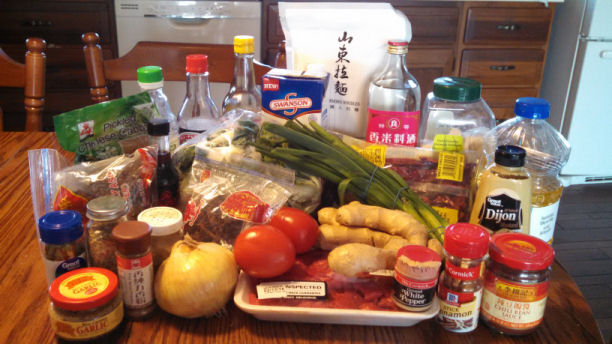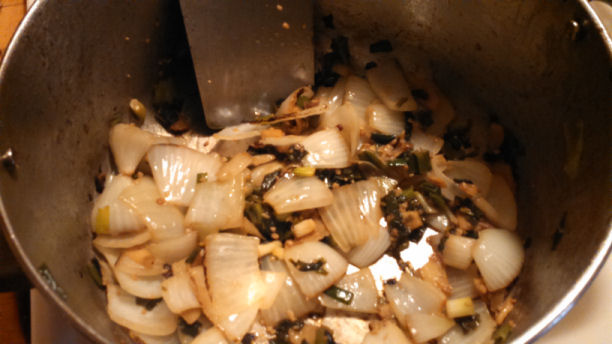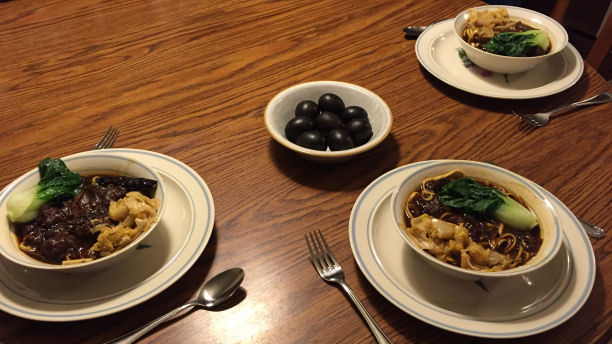So, as I mentioned yesterday, niu rou mian (in English, “beef noodles,” or, more specifically, beef noodle soup) was one of the first dishes I found when I started this week’s search, and it appealed to me right away. One source described it as “the ultimate Taiwanese comfort food.” It’s been cold and dreary here lately, so a hot, comforting soup sounded just about perfect.
Like most soups, it was going to take a little bit of effort and a fair amount of time – but first, it was going to take a fair amount of shopping, because (as was also true of the iron eggs), niu rou mian required some ingredients that I’d never used – or even seen – before. Luckily for me, there’s a new, big, shiny Asian grocery not too far from my house, so I was confident that I’d be able to find everything I needed there. That turned out to be a little more of a challenge than I’d anticipated, though, because once I started looking for some of the ingredients that I couldn’t immediately recognize just by looking at them (like “vegetarian oyster sauce” and “chili bean paste”), I discovered that quite a few products sold in the Asian grocery are (rather unsurprisingly) either not labeled in English at all or are labeled in English that, shall we say, did not involve the services of a professional translator.
(For one of the more comprehensible examples of that, the English text on the back of the bag of noodles I bought reads as follows:
CHOICENESS GROCERY NATION AFFIRMATION
We have already obtained the ISO certificate. It is non-fried and no preservatives. The quality is healthy and satisfying. You can set your mind at ease, because we can guarantee your expenditure.
Which is good, because a fried ISO certificate doesn’t sound very tasty!)
Anyway, this presented no problem when it came to noodles, seeing as they were unambiguously noodles (and, for the record, they were very good noodles, non-fried certificates notwithstanding). It got quite a bit trickier for less familiar ingredients. Luckily, I was mildly clever and came up with the idea of doing my own little backwards translation on my smartphone, which meant that I got a few funny looks as I held Mandarin translations of what I was looking for up next to assorted jars and bottles to look for the matching characters, but it worked! I had all the ingredients, and it was time to get started.
THE PROCESS
…and when I say I had all the ingredients, I mean I had all the ingredients in the world. Okay, not quite, but, well, look at the picture for yourself:

The good news, if you’re gasping in horror at the sheer size of that pile of ingredients, is that not all of them are actually for the soup. A few are for an entirely optional (but pretty tasty) garnish. Also, I ended up not actually putting in a cinnamon stick, because I forgot. The five-spice powder, which I did use, contains cinnamon, so I think it probably didn’t matter very much.
First, I found my nice, big pot that I basically only use when I’m making homemade soups on the stovetop. Pretty much everything one does for the soup itself will be done in that pot, which is nice from a not-adding-to-that-pile-of-dirty-dishes perspective. (You could use a skillet and a slow-cooker instead, if you wanted, but making sure I kept every single bit of the yummy residue from sautéing various ingredients in the soup was a big selling point of the “one pot” method for me.)
I started by pouring in a little vegetable oil, a sprinkle of sesame oil (for that extra touch of yummy smoky flavor), and about a teaspoon of raw sugar, heating that up a bit, and then dumping in roughly half the beef. (The bottom of one pot isn’t really big enough to do two pounds of stew meat at once very easily, but there’s no reason why you couldn’t cook it all at once if you were using a big skillet instead; just double the oils and sugar.) I cooked it for five or six minutes on medium-high heat until it was nicely browned on both sides, poured it (and all the liquid it generated) into a bowl, and then did the same thing with the other half of the beef. Once all the beef had been cooked, the pot came off the heat – but only temporarily, while I sliced up some veggies. I chopped eight large scallions, peeled and sliced a little more than one “finger” off that big ginger “hand” (so probably about a 4” by 2” piece of ginger?), and then into the pot they went, with a little more oil and another teaspoon of raw sugar. While they were getting thoroughly caramelized, I chopped the onion up into a few big chunks, and then added that and the minced garlic, and let those join the caramelizing party in the pan.

That smell was good. It was about to get even better. It was time for the herbs and spices – and I’m not talking about some measly little sprinkling.

Once the spices went in, along with the chili bean paste, I kept stirring and sautéing for a few more minutes, to get things nice and fragrant. And man, was it fragrant, in a very, very good way.

Once the whole house smelled so good I wanted to start chewing on passing air molecules, the beef went back in, along with the beef broth and about three to three and a half cups of water. I brought that up to a light boil, and then added the wine, the soy sauce, the tomatoes (cut into quarters), and the dried chili pepper. Then it was time to put the lid on the pot and let it simmer for a few hours while I wandered off to do other things, popping back into the kitchen to stir it a little every now and then. At the end of that process, the soup looked like this:

Now that I had definitely not dissolved any enemies into my soup (please don’t investigate me, any FBI agents who might be reading this – I swear I’m actually very boring and non-murderous), it was time to prepare a couple of garnishes to go on top.
Several recipes for niu rou mian mentioned topping it with “Chinese pickled greens” or something similar, but only one of them had a recipe for a tasty way to prepare said pickled greens right there next to her niu rou mian recipe. I ended up following her recipe pretty much exactly, so I’m just going to copy and paste it here:
430 g of pickled Chinese cabbage (“Suan-cai”. An olive-green pickled cabbage that’s usually vacuum-packed, and is sold at major Asian markets)
6 dried chili
2 tbsp of sake
2 tsp of sugar
3 tsp of rice vinegar, or white wine vinegar
1 1/2 tbsp of Dijon mustard
Pinch of white pepper
5 tbsp of oil
1 tbsp of sesame oil
Rinse the cabbage clean and squeeze dry. Remove the tough fibers at the head of the cabbage, then separate the stalks and the leaves. Finely chop or slice the stalks and soak in water for 4~5 min. Then chop the leaves finely and add to the stems (which has been soaking for 5 min), and soak for another 2 min. Take the cabbage out of the water and squeeze it completely dry.
Heat up the oil plus the sesame oil in a wok or skillet, toast the dried chili in the oil until the color has darken. Add the cabbage, sake, sugar, rice vinegar and Dijon mustard and stir frequently until the moisture from the cabbage has mostly evaporated, and the volume has shrunken down to almost 1/2. This will take several minutes. Finish by dusting with a pinch of white pepper.
This should keep in the fridge for up to 3 weeks.
Source: Lady and Pups (She seems to have a lot of tasty recipes, along with much more impressive photos than my mediocre cell phone shots!)
My cabbage didn’t end up looking as spiffy as her cabbage, probably because I was getting very hungry and thus didn’t have the patience either to let it dry completely before cooking it or to cook it all the way down to half its original volume. (I also think maybe the package of pickled cabbage I bought was a slightly different variety, because it was more “very pale green” than “olive green.”) Whatever, I’d have moist cabbage. I was hungry and it would do.
Having sautéed my cabbage, I quickly blanched some baby bok choy while waiting for the water to boil for the “noodle” part of my beef noodle soup. Noodles went in, noodles came out four minutes later, and then the soup was ready to be served! Into each bowl went a generous scoop of noodles, a couple of ladles of soup, and then a head of blanched baby bok choy on one side and a spoonful of sautéed cabbage on the other. (I had also meant to chop one more scallion and sprinkle a little of it over the top of each bowl, but did I mention I was really hungry by then? I was REALLY hungry by then. Under the circumstances, decorative scallion was just not in the cards.)
The bowls looked pretty decorative even without the scallion, anyway:

In fact, let’s bring the two entries on Taiwan together:

THE VERDICT
Om. Nom. Freaking. Nom.
Niu rou mian is, hands-down, one of the single tastiest soups I’ve ever eaten. The word both I and my dining companions kept using was “rich.” It is incredibly rich. Forget those chunky soups or whatever that advertise that they’re “soup that eats like a meal” – this is soup that eats like a meal. The beef is super tender and flavorful, the broth can barely be called “broth” because it’s so thick and, again, super flavorful, and the whole package taken together is downright scrumptious. I honestly don’t think it needed the cabbage or the bok choy, but they were both tasty with it. (The cabbage was also pretty tasty on its own as a snack the next day – as one would expect from a pickled cabbage, it tastes a lot like sauerkraut on its own, but the added ingredients after it was sauteed make it taste…well, still quite a bit like sauerkraut, but like tastier, more interesting sauerkraut.) And I just had a bowl of leftover niu rou mian as I was typing up this blog post, and I can add that it’s one of those foods that, if anything, gets even better as leftovers. (It definitely got a bit spicier, which I approve of – the original soup had a little heat to it, but was still in the “mild” range; a couple of days sitting in the fridge with that chili pepper hanging out in there helped kick it up to “medium.” If you want “medium” or higher from the start, a few more dried chilis or a couple more tablespoons of chili bean paste would probably do the trick.)
If I were to make this again (which I definitely, definitely will), I would change…pretty much nothing, honestly. Actually, I’ll amend that: I might replace the whole Sichuan peppercorns with ground Sichuan peppercorns, because whole ones require you to be a little careful while eating if you don’t want to bite down on the occasional hard peppercorn. That is really the only fault I can find with this soup, and it’s not exactly much of a fault.
Since I took longer than usual getting this week’s recipes posted, next week’s country will appear almost immediately after this post. Stay tuned!
THE INGREDIENTS
2 lbs beef chuck, cut into chunks (or sold conveniently pre-cut as “stew meat”)
8 large scallions
1 medium-sized piece of ginger, peeled and sliced
6 cloves minced garlic
1 large yellow onion
a few teaspoonfuls of raw sugar
a few tablespoonfuls of vegetable oil
a few sprinkles of sesame oil
2 tbsp chili bean paste
2 star anise “flowers”
4 bay leaves
1 tbsp fennel
2 tbsp Sichuan peppercorns/Chinese prickly ash
1 tsp cumin
1/4 tsp five spice powder
1/4 tsp black pepper
2 roma tomatoes, quartered
4 cups beef broth
3(ish) cups water
1 cup rice wine
1/3 cup dark soy sauce
1 dried chili pepper
any Asian wheat-based noodles (I used “Shandong” noodles)
baby bok choy
1 recipe sautéed Chinese cabbage (see above)

Taiwanese beef noodle soup is delicious! Somehow my mom’s was always better than any other. 🙂 One tip: for the spices you’re not going to actually eat, like star anise and bay leaves, those can be put in something like a coffee filter tied off with some cooking safe string, creating a satchel that can be easily removed later. My mom always does that. (the satchel is put in the soup as it simmers- some herbs like star anise don’t need to be sauteed first)
LikeLike